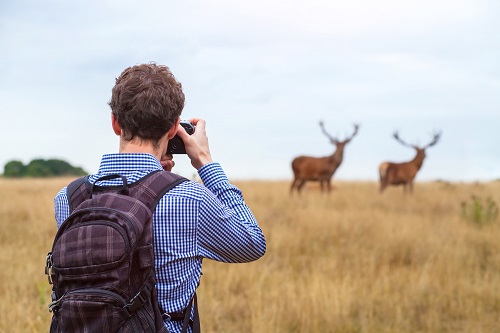Did you know there are rules for ethically photographing wildlife? If you’re interested in nature photography, it’s important to not only keep their safety in mind but also your own. While you’re not likely to get in trouble for getting too close to a grizzly bear in a national park, bad things can happen to you and the animal if things go awry. That’s why proper preparation and planning are important for getting started.
Read on to learn four of the most important nature photography tips.
1. Plan Your Pack:
The most important thing to do is plan your gear and plan your essentials. You’re going to need a good pair of hiking boots or shoes, and be sure to dress for whatever weather you’re going to be facing.
You’ll also need your photography gear. The basics we recommend you have are your camera (or phone), a tripod, and a camera bag.
For a bag, brands like Rep The Wild are perfect for getting started. As you build, you’re likely to acquire new lenses and other equipment, but those three things are more than enough to get started with.
2. Keep Your Distance:
Once everything is packed up and ready, it’s time to take to the trails. This is where being considerate of animals is going to become important. Don’t get too close, and don’t do anything irresponsible like attempting to feed or throw things at them for attention.
Animals scare easily, so it’s best to keep your distance, settle in, and try to remain quiet while capturing your shots.
3. Try New Angles:
No matter what gear you have or where you’re hiking, trying new angles and perspectives is essential. It can be as simple as getting lower with your shots rather than standing or climbing onto rocks or trees to gain a new perspective. It might not seem like much, but those extra few feet can make all the difference.
When you’re learning about photography essentials, you’ll likely hear about the rule of thirds (which is important), but you might not think to use things like a boardwalk rail as a tripod, or a rock to get a unique angle.
Remember to get creative, and don’t fret if you don’t have a tripod. There are a ton of things you can use to replace the equipment you’re lacking.
4. Don’t Overthink:
When you’re working to become a photographer, it’s easy to get caught up in the small details of every shot. You want to catch the perfect moment every time, but it’s important to remember that that’s not going to happen.
You can’t control the things that happen in nature, you can only be there at the perfect moment. Patience is key with this type of photography, and so is plenty of practice.
Have Fun With Nature Photography!
Once you have these few principles down, it’s going to be a lot easier to enjoy yourself. There’s always something new to learn, and there’s never a dull moment when you’re out hunting for photos! Have faith in your nature photography preparation, and have faith in your process.
For more on the latest in photography and technology, check out the rest of our website.

